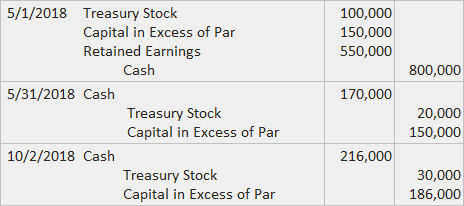The par value method is based on the assumption that the acquisition of treasury stock is essentially a permanent reduction in stockholders' equity. The entries used in the method are thus structured as if the shares have been retired. At the time of acquisition, the Treasury Stock account is debited for the par value of the shares, and Capital in Excess of Par is debited for the original amount paid in excess of par at issuance. Cash is credited for the acquisition price. If the cost is less than the original issue price, Additional Paid-In Capital should be credited. If the cost exceeds the original issue price, Additional Paid-In Capital or Retained Earnings should be debited. When the shares are reissued, Cash is debited for the proceeds and Treasury Stock is credited for the par value of the shares. Any additional credit is recorded in Capital in Excess of Par, just as if the stock is being issued for the first time. This entry reflects the position that treasury stock is in substance the same as any other unissued shares. If the capital stock in the previous example had an initial issue price of $25 per share, the following entries would be recorded for the three events: Under the par value method, the Treasury Stock account should be viewed as contra to the Capital Stock account. Its balance represents only the claims arising from the original investment of par value that were satisfied by distributing assets. Disclosure of the number of shares can be accomplished as follows: If more than one class of stock exists, separate disclosures should be made for the treasury stock of each class. For no-par stock with a stated value, the entries for the purchase and sale of treasury shares are the same as those described above. However, if the stock does not have a par or stated value, the original full amount paid in substitutes for par value in the entry for acquisitions, as shown below (again assuming an original issue price of $25 per share): Upon reissuance, any amount received in excess of the carrying amount of the treasury shares must be credited to the Capital Stock account. This is because no other paid-in capital account exists for no-par-value stock. Furthermore, this practice produces the same account balances that would be achieved if the stock had been retired and new shares issued. The following reissuance entries would be recorded for the example:

Entries for Stock Without Par Value



Par Value Method of Treasury Stock FAQs
Treasury Stock simply refers to shares of company stock that have been repurchased by the issuing corporation. These are shares that have been bought back by the company either because it has no further use for them or because they think the stock is undervalued and represents a good investment.
The par value method of Treasury Stock involves recording a purchase of treasury shares at the stated or par value per share. The difference between the price paid and the stated/par value per share is then treated as a distribution to common stockholders and debited to capital in excess of par if it exceeds par.
To record Treasury Stock using the par value accounting method, you would debit cash for the purchase price of the Treasury Stock and credit capital in excess of par for any excess paid above par. Alternatively, you would debit additional paid-in capital or Retained Earnings for any deficit incurred when reissuing treasury shares. Cash is credited when stock is reissued.
The par value method of accounting for treasury shares is typically used when a company does not have a stated or par value on its stock, since no other paid-in capital account exists. Using this accounting method results in the same balance sheet figures as if the company disbursed the cash to shareholders and reissued new stock.
No-par stock does not have a stated or par value per share, while par value stocks do.
True Tamplin is a published author, public speaker, CEO of UpDigital, and founder of Finance Strategists.
True is a Certified Educator in Personal Finance (CEPF®), author of The Handy Financial Ratios Guide, a member of the Society for Advancing Business Editing and Writing, contributes to his financial education site, Finance Strategists, and has spoken to various financial communities such as the CFA Institute, as well as university students like his Alma mater, Biola University, where he received a bachelor of science in business and data analytics.
To learn more about True, visit his personal website or view his author profiles on Amazon, Nasdaq and Forbes.











